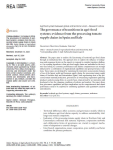Mantino F., Forcina B. (2024). The governance of transitions in agri-food systems: evidence from the processing tomato supply chains in Spain and Italy. REA. Rivista di economia agraria, 25/07/2024, vol. 79, n. 1, p. 15-32.
https://doi.org/10.36253/rea-14953
https://doi.org/10.36253/rea-14953
| Titre : | The governance of transitions in agri-food systems: evidence from the processing tomato supply chains in Spain and Italy (2024) |
| Auteurs : | F. Mantino ; B. Forcina |
| Type de document : | Article |
| Dans : | REA. Rivista di economia agraria (vol. 79, n. 1, July 2024) |
| Article en page(s) : | p. 15-32 |
| Langues : | Anglais |
| Langues du résumé : | Anglais |
| Catégories : |
Catégories principales 08 - ALIMENTATION ; 8.3 - Politique et Sécurité AlimentaireThésaurus IAMM SYSTEME AGROALIMENTAIRE ; SYSTEME ALIMENTAIRE ALTERNATIF ; SYSTEME DE PRODUCTION LOCALISE ; ECHELLE SPATIALE ; TERRITOIRE ; TOMATE ; TOMATE D'INDUSTRIE ; FILIERE ; ITALIE ; ESPAGNE |
| Résumé : | The paper aims to analyse the functioning of territorial agri-food chains through an institutional lens. The approach tries to explore the influence of endogenous and exogenous factors on the capacity to respond to complex transition challenges. Our working hypothesis is that agri-food supply chains are embedded in the territory they belong to, economic performances and market competitiveness are strongly influenced by a combination of organisational capabilities and good governance solutions. These topics are developed by examining the innovative socioeconomic features of two of the largest world and European supply chains: the processing tomato supply chains of Northern Italy and Extremadura (Spain), both representing most of the processed tomato national production, governed by an overarching organisation gathering producers and processing firms on a parity basis, characterised by an innovative path developed to face the changing conditions of policies and markets. The paper shows how governance capabilities and their implications on the competitiveness and chain?s performance need to be explored by combining qualitative and quantitative analysis and indicators. |
| Cote : | En ligne |
| URL / DOI : | https://doi.org/10.36253/rea-14953 |







